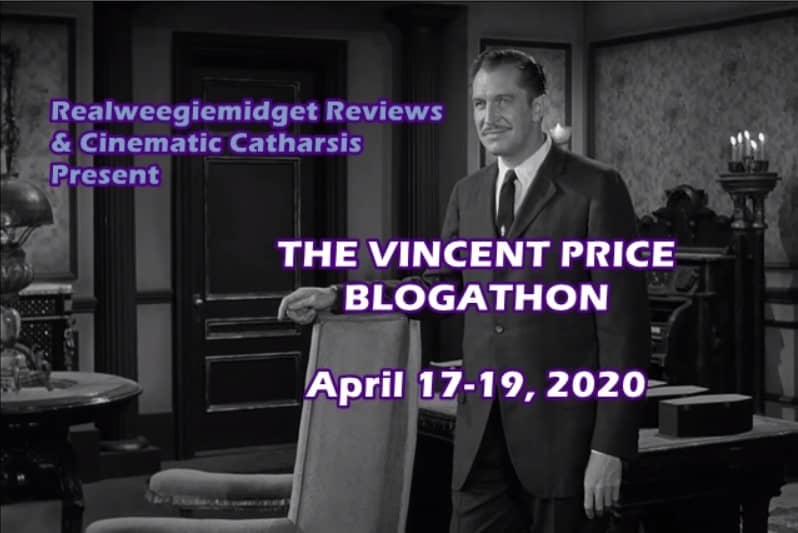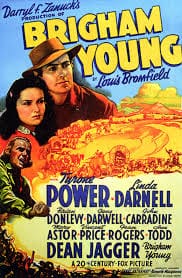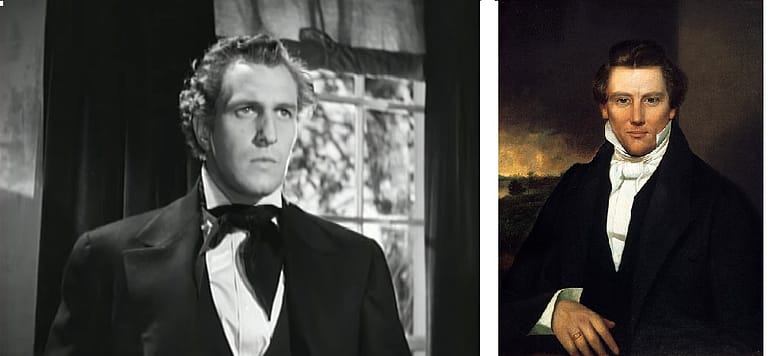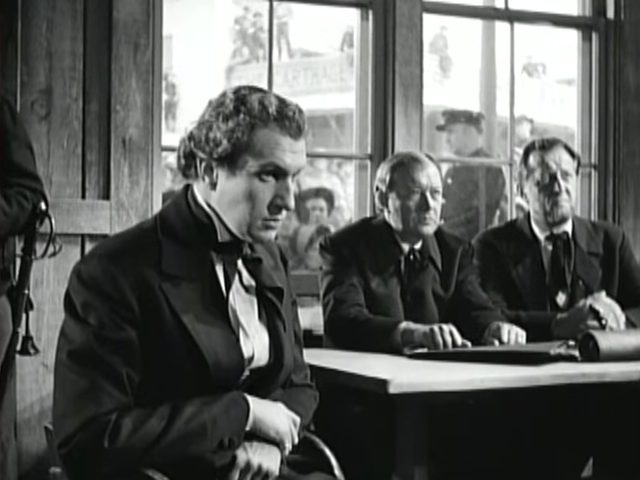
The Hollywood studio system was an intricate, and well-oiled machine in the 1930s and 40s, an oligarchy of a handful of studios that controlled the production, distribution, and exhibition of films with an iron fist. During their height, movie studios scrupulously controlled the careers and images of their actors, assigning them to roles they thought would build their stars’ personas or best help the studio’s bottom line, often without the input of the actor.
Vincent Price made the jump from the theater to the screen during this golden age of the Hollywood studio system, signing a contract with Universal in the late 1930s. After playing a few small parts as a character actor, his contract ended and he immediately signed with 20th Century Fox. In his first role under his new Fox contract, the studio assigned him to play Joseph Smith, the American religious leader and founder of what would become the Church of Jesus Christ of Latter-day Saints, in the 1940 film Brigham Young.
This post is part of the Vincent Price blogathon hosted by Cinematic Cartharsis and Realweegiemidget Reviews. Make sure to read other great posts by my fellow bloggers celebrating Vincent Price’s career.
Price playing a 19th-century religious leader seems quite out of step with Price’s horror image that we associate with him today but this was long before he established himself as a star of any caliber in the filmmaking business. Most of his theater performances were in dramatic roles such as his first big breakout Broadway role on the stage playing Prince Albert alongside Helen Hayes in Victoria Regina. His roles in his early Universal films merely mirrored his stage roles and persona as a dramatic actor. His role in Brigham Young was no different.

Just a warning, this is not the Mormon version of Red River despite what the poster seems to suggest.
Stranger than his role in the film was the film’s existence at all. Even in a time in history when Americans more actively participated in organized religion, an epic about the polygamous Mormon pioneer Brigham Young doesn’t scream box office success. Outside of Utah, Brigham Young was most well-known by many as the punch-line of polygamy jokes, being featured in numerous 19th and 20th-century political cartoons, Victorian literature, and vaudeville routines. Numerous books, cartoons, and even films, such as A Mormon Maid (1917) or Trapped by the Mormons (1922), portrayed Brigham Young and his Mormon ‘tribe’ as predatory religious fanatics who kidnapped young women to add to their harem of wives.
Despite these previous depictions of Mormons in media and popular culture, Daryl Zanuck thought an emphatic story of Mormon persecution could resonate with pre-World War II Americans. Zanuck was quite aware of the challenges of adapting the film, stating himself in a letter to the film’s first treatment’s author Eleanor Harris that “there is no way that you can conceivably excuse to audiences of the world the idea of one man having eight or nine-bed companions”. Understanding the risk, he was also confident in his writers’ ability to craft a story that could both follow the Production Code and shed a more positive light on Brigham Young.
Zanuck’s writers created a fairly straightforward and whitewashed, if not completely accurate, retelling of events in Mormon history from the martyrdom of Joseph Smith to the Brigham-lead exodus of the saints across the plains and their settlement of Utah. The narrative of Brigham Young was couched in the lives of two romantic leads who experience Mormon historical events and interact with historical Mormon figures.
Joseph Smith’s role as a tragic hero in the film also serves to side the viewers’ sympathies with Young and the Mormons, regardless of the audiences’ previous knowledge or experiences with the church. Although Vincent Price’s screen time barely adds up to more than ten minutes, his role as Joseph Smith in the film’s opening scenes is crucial. Price’s presence both elicits sympathy from the audience and demands a haunting presence over the remainder of the film as Brigham Young struggles to live up to Joseph Smith’s leadership, driving his character’s growth throughout the film.

Vincent Price compared to the most historically accurate picture of Joseph Smith.
Price plays Joseph Smith as a soft-spoken and humble man who also has the qualities of a strong, clear-headed leader. This is shown best in his first scene in the picture as he discusses with other church leaders how they should respond to the latest attacks from local Illinois settlers. As Smith enters the room, he towers over the other men sitting around a table facing away from us. Smith speaks quietly, humbly asking for the others’ opinions on the matter. He paces after listening to the varying viewpoints, keeping calm even as tempers flare. Some vehemently call for retaliation while others argue for yet another attempt at peace with their unfriendly neighbors.
As Joseph stews over the situation while glaring out the window, the well-known Mormon hymn “The Spirit of God” swells up in the background as he turns to address the room. He emphatically and courageously declares that they will fight. As the antagonist Angus Duncan raises his voice to oppose, Smith defiantly proclaims that he is through with turning the other cheek and calls for the men to grab their guns. Price’s ability to convey a humble yet strong-headed leader establishes Smith as a compassionate, level-headed leader who leads not out of a desire for power but for the benefit of his people.
Smith’s image as a humble leader is solidified when he is brought before the county court hellbent on his and his people’s explosion from Illinois. While before he towered over his fellow church leaders, in the courtroom he sits cowered in a chair, willing to accept the will of God whether it is fair or not. As Joseph sits passively condemned, Brigham Young makes his first appearance in the film, standing up from the crowd to defend Joseph, foreshadowing Brigham’s ascent to lead the Mormons after Smith’s upcoming death.

Like a man going as a lamb to the slaughter
We are shown a flashback scene of Brigham first meeting Joseph as he recounts the story to the courtroom. Brigham and his friend Heber come to Joseph’s home to ask him about his religion only to find him chopping wood, a very unprophetic thing for him to do they both agree. Price’s towering and large figure combined with his confidence and honesty while he converses with Brigham and his friend further set up Joseph Smith as a hardworking and honest individual. Smith talks about God’s plan for His people to work together and share labor and wealth among them. Brigham shares Smith’s grit, accepting Joseph’s views and exclaiming that he isn’t looking for an easy religion. As we return to the courtroom, Brigham ends his appeal to the jury leaning on Smith’s outstanding character.
Of course, the biased jury gives the verdict of guilty, sending Smith to the small county jail in Carthage. While Brigham’s speech to the hostile jury, judge, and courtroom audience fails to sway the jury, it firmly connects Brigham with Joseph as his equal. This is further solidified as Joseph orders Brigham to stay behind and take care of his people as he is whisked off to the county jail in Carthage. Mere seconds before an angry mob attacks and murders Smith, he prophesies to his cellmates that one will be raised up by the Lord to take Smith’s place and lead His people as Moses led the children of Israel. That’s pretty high praise for his successor.
Price’s second screen death out of forty-three
As the rest of the film unfolds, Brigham Young struggles to lead as Joseph did, often questioning whether he was right to take charge of the church. Even as he fulfills Joseph Smith’s prophecy by leading the people across the plains as an American Moses, Young doubts his own capability to hear the voice of God and do His will for the people. Joseph Smith is only mentioned a couple of times in the rest of the film but his presence and legacy weigh heavily on Brigham up until the film’s climax. Brigham seems to always wonder why Joseph could seem to speak the words of God and he was left to lead with no such divine direction, just his own thoughts.
Vincent Price’s role as Joseph Smith in the film sets forth the major problems that our main character Brigham and his Mormon followers face. The audience empathizes with the Mormons after seeing a perfectly upright, humble, and confident leader be wrongfully killed for his message of peace. After his death, the saints are not only in grave danger but in need of a new leader. Brigham has Joseph’s mantle placed upon him by Joseph and the Lord with little way to live up to such a high challenge.
The film clearly sets itself up not as an exploration of Brigham Young as a controversial and multi-layered historical figure but as a sympathetic look into Brigham Young’s personal journey in becoming an American Moses and leader. Perhaps Vincent Price himself said it best when he noted that Brigham Young “really diddled with the facts: he had one wife here”. It’s unfortunate the film picks to tell a whitewashed version of the outspoken racist and sexist early Mormon leader’s life and merely uses the misogynistic practice of polygamy as comic relief but that is a blog post for another day.
For modern-day viewers unfamiliar with Mormon history or culture, Brigham Young may be a bit off-putting, confusing, or unappealing; however, Vincent Price’s key performance as Joseph Smith is well worth a watch for any Price completist to better understand his image and talent in the earlier part of his career. Price’s ability to craft a well-defined character in such little screentime that remains a key part of the narrative long after his character’s death shows his blossoming talent as an actor that he would build on for years to come.




Great article! I learned a lot I did not know about both the production of the film and Brigham Young. Thanks very much.
I’ve always thought that 20th century Fox often took chances on pictures that other studios wouldn’t touch.
Sounds like Brigham Young would fall into this category.